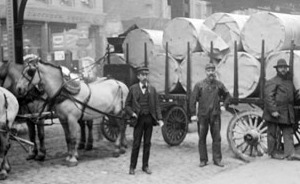talking history | syllabi | students | teachers | puzzle | about us
Photographs from the Chicago Daily News: 1902–1933,
http://memory.loc.gov/ammem/ndlpcoop/ichihtml/cdnhome.html
Created and maintained by the Library of Congress.
Reviewed Nov.–Dec. 2010.
Anyone familiar with the Library of Congress’s wonderful American Memory collection already knows how to use this collection of photos from the Chicago Daily News as it is part of that cyber-repository. It offers 55,000 shots taken by newspaper photographers between 1902 and 1933 and mainly housed today at the Chicago Historical Society. Like any other American Memory collection, it is searchable and browseable by subject and name and includes a series of “Topics to Explore” that range from Christmas activities to newsboys.

"Unloading rolls of paper from a horse drawn cart for
the Chicago Daily News press," Chicago Daily News, Inc.
The pictures offer a broad panorama of urban life in the early twentieth century, including people, places, and events. They illustrate many themes relevant to the era, including immigrants, transportation, work, war, and entertainment. Not surprisingly, given the source, many focus on the elements of city life that made news in the early twentieth century. Strikes, fires, and calamities are broadly represented, as is the concept of civic responsibility in the form of orphanages and campaigns; but the collection also runs heavily to sports and portraits of individuals, famous and not so famous.
One of the frustrations of the collection is that it is not quickly searchable for the kind of photo a historian might use, either as research or to show to a class. The subjects are generally organized by name, building, or street, yet the broader “topics” are limited. Searches for the World War I Chicago home front, for example, turn up few pictures that fit what that description conjures for most historians — images of civilians making do, getting by, and helping the war effort. Rather, there are lots of troop trains and photos of Gen. John J. Pershing. Some photos pique a browser’s interest without providing satisfaction. What is one to make of a photo of Celia Demitero, kidnapped, the brief text states, “by gypsies in Little Rock, Arkansas” and reunited with her parents eleven months later? Without access to something such as the Chicago Tribune online archive, Demitero’s story must go untold. As a Greek American who had family living in Chicago in this period, I hoped to get a sense of what their lives were like from this collection, and it may be that there are photographs that provide a better sense of the texture of their lives, but I could not find them. A search of “Halsted Street,” for instance, turned up mainly bridges and bombings.
The quality of the photographs varies considerably. Some are pristine while others are scratched and damaged around the edges. However, the identification of each is exact, demonstrating emerging notions of professionalism in journalism. Photographers must have carefully taken down names, dates, and descriptions, all of which were stored by the paper.
This is a collection of marvelous texture and possibilities, limited somewhat by format, but useful to urban historians, historians of the Progressive Era, and anyone with a working knowledge of Chicago history.
Judy Kutulas
St. Olaf College
Northfield, Minnesota
